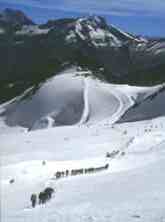Scale a Peak in
Switzerland's Rugged Alps
He listened while I told him about my climbing experience; thought for a moment, then flashed a quick smile. "I think," he said as he crossed my name off one list and scribbled it on another, "you'll like this climb. Some glacier traveling, rock climbing, sections with ice. Much more interesting."
|
I was in the Swiss Alps village of Zermatt at the Bergfuhrerburo, or Alpine Center, a
mountaineering-guide business, planning a climb up one of the region's 4000-plus meter
(13,200-plus feet) peaks. He handed me a card with a meeting time and place and the mountain's name, Pollux. I'd viewed the mountain a day earlier during a day hike. At 4091 meters (13,533 feet), Pollux had appeared as a dimple among the loftier, more massive neighboring mountains that form a jagged wall between Monte Rosa and the Matterhorn. |
Flash forward a day later ... Directly in front of me was a frighteningly "interesting," virtually vertical rock wall. Draped from the wall was a stout chain fastened with strong bolts. At first glance there seemed to be no toe holds or places to jam a finger or elbow, just a slick slab of stone.
Three others — Perren Benedict, the Zermatt guide who was leading me, and his two Swiss clients, Roland Aeppli and H.R. Honeggen — seemed unconcerned as they fed out our climbing rope. Like a spider, Benedict nimble-footed his way up the wall and prepared his belay. I hoped it was the intense snow-reflected heat that had me sweating. I wondered if I'd been too assumptively confident.
| The Allalinhorn, A "Piece of Cake" A week earlier, while in the Swiss Alps village of Saas-Fee, I'd managed to hook-up with a guide-led climbing group up the Allalinhorn, a 4027 meter (13,289 feet) peak. Martin Volken, who was born in Switzerland and divides his time between Saas-Fee and his climbing-guiding business in Seattle, Washington, led the way. Allalinhorn is the quintessential "piece of cake." A combination of multi-passenger gondolas and an underground Alpin Express train takes climbers, downhill skiers, snowboarders and camera-toting tourists to Mittel Allain, at 3454 meters. From there it's possible to dine or slurp a soda at a revolving restaurant. As it rotates, the windows offer views of the year-round glacial downhill ski area, an awesome bowl lipped with a series of 4000-plus meter peaks, and the valley that plunges toward Saas Fee. |
 A parade of climbers begins the trek up the Allalinhorn. |
There's even a mesmerizing ice grotto under the restaurant. Visitors can descend inside a glacier and, most stunningly, peer into the heart of a deep crevasse with weirdly fascinating, and frightening, ice formations.
Mittel Allain is also the takeoff point for the Allalinhorn. The elevation gain is only 573 meters, or 1,891 vertical feet. By way of comparison, a climb up 14,162-foot Mount Shasta in far Northern California from the usual starting point at Horse Camp requires an elevation gain of about 6,000 feet.
Our group of five began the gradual ascent up the Allalinhorn in relaxed style. Where the terrain steepened, we tied into the umbilical cord-like rope. The others had crampons and climbing poles, but they weren't really necessary. The "climb" was really a walk, a very beautiful eye-popping open walk. As we angled around a col, the view revealed the heart of the Valaisan Alps, a range of soaring, sometimes ragged, sometimes graceful peaks, including the dramatic blade that is the Matterhorn.
|
|
Continuing up the Allalinhorn, a cross marked the mountain's summit. Minutes later our climbing group, like a series of others before and following us, paused for quick photos before dropping to a wind-protected ledge for a mid-morning brunch.
In good weather Allalinhorn is a walk suitable for anyone in reasonable fitness. Allainhorn is a mountain for people who have never climbed and wonder, "Why do people climb?"
Ah, The Difference With Pollux
Not Pollux. By the time we reached the steep wall, my "Why?" conjured up all sorts of other questions. Actually, the climb up Pollux started rather inauspiciously. A series of gondolas climbed up and up, eventually to the 3883 meter Klein Matterhorn. From there we dropped onto a glacier, which we followed around and past the bulky mass of the 4160 meter Breithorn.
For several kilometers we trailed along crevasses to Pollux's east side, where we left the snow and weaved up a steep, rocky, barely discernible route that led to the imposing rock wall. Not only was it intimidating, but the scene was crazed. Another group was rappelling down, their out-of-control descent creating a confused tangle as I struggled up, jamming hands and fingers into tiny cracks while my toes searched for pebble-sized footholds.
|
|
Up, up and more up. One rope length, then a second. But the top of the wall wasn't the summit. We fitted on our crampons and teetered along a sharply angular, knife-like ridge to the place where we could climb no more. From the top we gazed at a sea of glaciers and a sweep of broad, dominating peaks, including the bulging 4527 meter Liskamm and the Monte Rosa, where the highest of its double-tipped peaks reaches 4634 meters.
The descent down Pollux was relatively uneventful. A few hours later we rehydrated on the sun-drenched deck at a mountain inn. "Interesting," I thought, recalling the mountaineering guide's assessment. "Much more interesting."
Click here for details to plan your trip to Saas-Fee and Zermatt, Switzerland.
Lee Juillerat
Article and photos
Lee is a freelance writer-photographer who lives in Southern Oregon, where he is the regional editor for the Klamath Falls Herald and News.